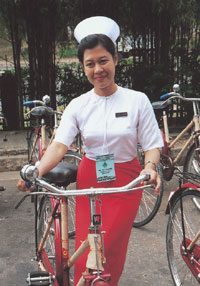The Red Angels
This past January, Myanmar achieved elimination
of leprosy. Its success has highlighted the
effective techniques that it used to get there.
This is especially so since, 40 years ago,
Myanmar had one of the highest prevalence rates
in the world.
One problem that developing countries have
in dealing with such issues is the lack of monetary
resources. Those few resources that exist must be
allocated with the maximum possible efficacy if
they are to have any effect at all.
Thus in 1978, rather than devote all of its
money to central hospitals, Myanmar embarked
on a People's Health Plan under which it
included leprosy control as a part of its Basic
Health Services (BHS). At that time, Myanmar
had the highest number of patients in its
recorded history - 270,000.
Before this 1978 change, leprosy control
activities largely took the form of house calls made
by vertical staff - leprosy experts. In those days,
Multi-Drug Therapy (MDT) coverage and patient
compliance were relatively low. However, by
integrating leprosy services into BHS, the
government gave leprosy-affected people access to
the country's wide network of Red Angels -
official midwives who are responsible for the
general health of people who live in villages.
When this happened, the nation's patients became
increasingly accessible to its service providers.
MDT coverage and treatment compliance improved. Additionally, stigmatization among the
people was reduced. While the vertical staff
remain today, they have taken on the role of
technical supervisors to the general health services.
The Red Angels, on the other hand, travel
from village to village in their red skirts, riding
red bicycles. They go from home to home,
finding new cases and delivering the medicines
needed to cure the disease. The use of these
much-loved women is a much more proactive
and humane way of reaching patients than
requiring them to visit hospitals.
These grass-roots workers are perhaps the
largest reason, after the free distribution of
MDT, for Myanmar's recent success. As always,
it is people working closely with people that has
proven to be the best way to deal with human
problems. |

A Red Angel
with her bicycle |
| Correction - |
On Page 5 of the April 2003 issue, the name of the Nepalese Health Minister, Professor Upendra Devkota, FRCS, was incorrectly spelled.
We apologize for any inconvenience this may have caused. |
| WHO Special Ambassador's Newsletter |
| No.2,June 1,2003 |
|
| |
| Publisher |
Editorial Office |
| Yohei Sasakawa |
WHO Special Ambassador's Newsletter |
Editor in Chief
Tatsuya Tanami |
5th Floor, Nippon Foundation Building |
| 1-2-2 Akasaka, Minato-ku, Tokyo 107-8404, Japan |
Proofing Editor
James Huffman |
Telephone: +81-3-6229-5601 Fax: +81-3-6229-5602 |
| Email: smhf_an@tnfb.jp |
| Contributing Staff |
With support from: |
| Ron Faxon, Akiko Nozawa |
The Sasakawa Memorial Health Foundation, |
| Photographer |
The Nippon Foundation |
| Natsuko Tominaga |
www.nippon-foundation.or.jp/eng/ |
| Contributions or comments should be addressed to the Editorial Office as listed above |
|
| (C) 2003 The Nippon Foundation. All rights are reserved by the foundation. This document may, however, be freely reviewed, abstracted, reproduced or translated, in part or in whole, but not for sale or for use in conjunction with commercial purposes. The responsibility for facts and opinions in this publication rests exclusively with the editors and contributors, and their interpretations do not necessarily reflect the views or policy of the Special Ambassador's Office. |
|